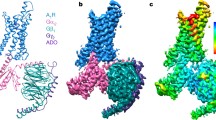Abstract
Adenosine is a naturally occurring purine nucleoside that has a wide variety of well-documented regulatory functions and physiological roles. Selective activation of the adenosine A1 receptor has drawn attention in drug discovery for the therapeutic effects on neural and cardiovascular disorders. We have developed a model of the human A1 adenosine receptor using bovine rhodopsin as a template. A flexible docking approach has been subsequently carried out for evaluating the molecular interactions of twenty-one selective A1 agonists with the receptor model. The results of these studies are consistent with mutational and biochemical data. In particular, they highlight a wide hydrogen-bonding network between the nucleoside portion of the ligands and the A1 receptor as well as key amino acids for hydrophobic interactions with the different N6-groups of the agonists. The models presented here provide a detailed molecular map for the selective stimulation of the adenosine A1 receptor subtype and a steady basis for the rational design of new A1 selective ligands.
Similar content being viewed by others
References
Dunwiddie, T.V., Masino, S., Annu. Rev. Neurosci., 24 (2001) 31.
Klotz, K.N., Naunyn-Schmiedeberg's Arch. Pharmacol., 362 (2000) 382.
Hess, S., Exp. Opin. Ther. Patents, 11 (2001) 1533.
IJzerman, A.P., van Galen, P.J.M., Jacobson, K.A., Drug Des. Discov., 9 (1992) 49.
Baraldi P.G., Cacciari B., Moro S., Spalluto G., Pastorin G., Da Ros T., Klotz K.N., Varani K., Gessi S., Borea P.A., J. Med. Chem., 45 (2002) 770.
Baraldi, P.G., Cacciari, B., Romagnoli, R., Spalluto, G., Exp. Opin. Ther. Patents, 9 (1999) 515.
Palczewski, K., Kumasaka, T., Hori, T., Behnke, C.A., Motoshima, H., Fox, B.A., Le Trong, I., Teller, D.C., Okada, T., Stenkamp, R.E., Yamamoto, M., Miyano, M., Science, 289 (2000) 739.
a) Muller, C.E., Curr. Med. Chemistry, 7 (2000) 1269; b) Knutsen, L.J.S., Lau, J., Petersen, H., Thomsen, C., Weis, J.U., Shalmi, M., Judge, M.E., Hansen, A.J., Sheardown, M.J., J. Med. Chem., 42 (1999) 3463.
Bairoch, A., Apweiler, R., Nucleic Acids Res., 28 (2000) 45.
Thompson, J.D., Higgins, D.G., Gibson, T.J., Nucleic Acids Res., 22 (1994) 4673.
Morgenstern, B., Frech, K., Dress, A., Werner, T., Bioinformatics, 14 (1998) 290.
Clamp, M., http://www.ebi.ac.uk/~michele/jalview/, (1998).
Jones, D.T., Taylor, W.R., Thornton, J.M., Biochemistry, 33 (1994) 3038.
Jones, D.T., J. Mol. Biol., 287 (1999)797.
a) Rost, B. and Sander, C., J. Mol. Biol., 232 (1993), 584; b) Rost, B. and Sander C., Proteins, Struct. Funct. Genet., 19 (1994) 55; c) Rost, B., Sander, C., Schneider, R., CABIOS, 10 (1994) 53.
Jones, D.T., J. Mol. Biol. 292 (1999) 195.
Berman, H.M., Westbrook, J., Feng, Z., Gilliland, G., Beth, T.N., Weissig, H., Shindyalov, I.N., Bourne, P.E., Nucleic Acids Res., 28 (2000) 235.
Šali, A., Blundell, T.L., J. Mol. Biol., 234 (1993) 779.
a) Jones, T.A., Thirup, S., EMBO J., 5 (1986) 819; b) Claessens, M., Van Cutsem, E., Lasters, I., Wodak, S., Prot. Eng., 2 (1989) 335.
Pearlman, D.A., Case, D.A., Caldwell, J.W., Kollman, P., Comp. Phys. Comm., 91 (1995) 1.
Laskowski, R.A., MacArthur, M.W., Moss, D.S., Thornton, J.M., J. Appl. Cryst., 26 (1993) 283.
McMartin C., Bohacek R., J. Comput. Aided-Mol. Des., 11 (1997) 333.
Olah, M.E., Ren, H., Ostrowski, J., Jacobson, K.A., Stiles, G., J. Biol. Chem., 267 (1992) 10764.
Townsend-Nicholson, A., Schonfeld, P.R., J. Biol. Chem., 269 (1994) 2373.
Rivkees, S.A., Barbhaiya, H., Ijzerman, A.P., J. Biol. Chem., 274 (1999) 3617.
Barbhaiya, H., McClain, R., Ijzerman, A.P., Rivkees, S.A., Mol. Pharmacol., 50 (1996) 1635.
Fredholm, B.B., Ijzerman, A.P., Jacobson, K.A., Klota, K.-N., Linden J., Pharmacol. Rev., 53 (2001) 527.
Author information
Authors and Affiliations
Rights and permissions
About this article
Cite this article
Giordanetto, F., Fossa, P., Menozzi, G. et al. Exploring the molecular basis of selectivity in A1 adenosine receptors agonists: a case study. J Comput Aided Mol Des 17, 39–51 (2003). https://doi.org/10.1023/A:1024530029922
Issue Date:
DOI: https://doi.org/10.1023/A:1024530029922



